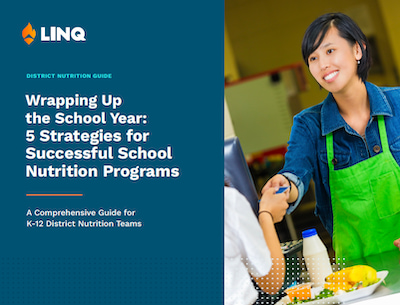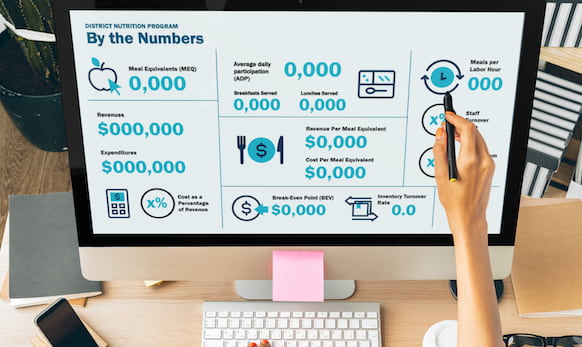School nutrition program key performance indicators (KPIs) reveal the hard work and impact of every district’s unsung heroes: nutrition staff. That’s why it’s vital to report on your program’s success. To make showcasing your program’s value easier for busy K‑12 nutrition directors, we created a helpful school nutrition KPI template for you to use. Save it, then update it monthly, quarterly, and/or annually.
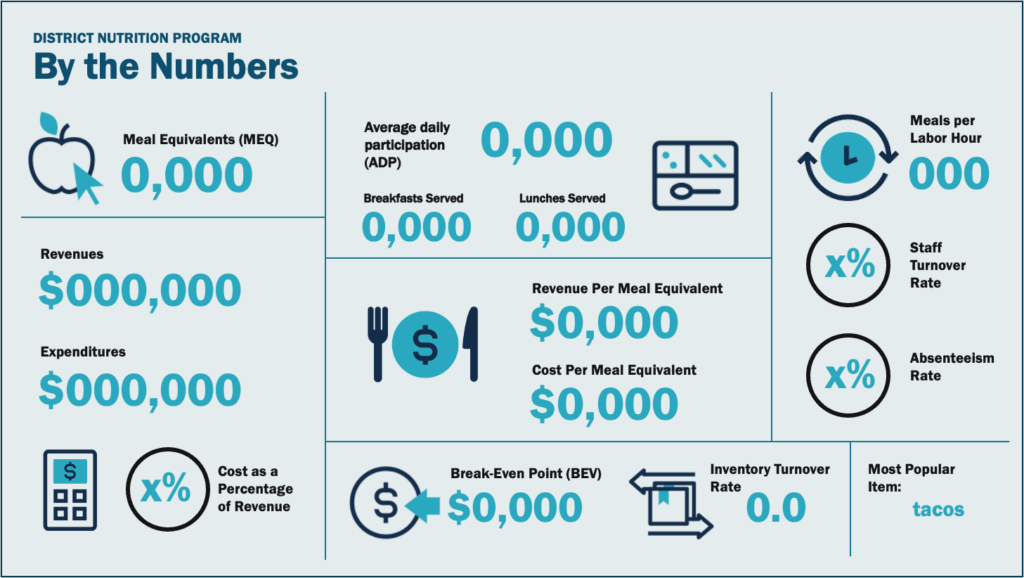
Why showcasing your school nutrition program KPIs matters
School nutrition professionals deserve recognition. Plus, as the School Nutrition Association (SNA) points out, regularly recording vital performance data gives nutrition directors the information they need to make data-driven decisions. Presenting your program’s KPIs to district leaders, stakeholders, and staff members helps you tell your success story in hard facts and data. This can help your program stay front-of-mind in budget, operations, and procurement discussions.
Celebrate the effort that goes into keeping students fed so they can learn. Plus, update the template at a regular cadence for a powerful historical data reference to drive informed decisions and continuously improve your program. In this blog, we look at how you can use this reporting template to:
- Show off your school nutrition team’s hard work
- Tell your program’s value and success story
- Make data-driven school nutrition decisions
Show off your school nutrition team’s hard work
School nutrition staff always played a crucial role in students’ education experience, but it was the early days of the pandemic in 2020 when many took note. Suddenly, nutrition teams made headlines and got segments on the local news. Their tireless efforts to deliver meals even when buildings were closed and buses were parked won the hearts of many. It quickly became clear how many students depend on school breakfast and lunch each week due to food insecurity at home.
However, once school operations more-or-less returned to normal, fanfare for K‑12 nutrition teams faded. That’s why it’s more important than ever to shine the spotlight on them at every opportunity. Our school nutrition KPI template includes several metrics recognizing your nutrition staff’s impact on student wellbeing. Use these metrics to celebrate the number of meals they serve, how efficiently they provide meals, and how many students they support each day.
These KPIs reflect your school nutrition staff’s hard work:
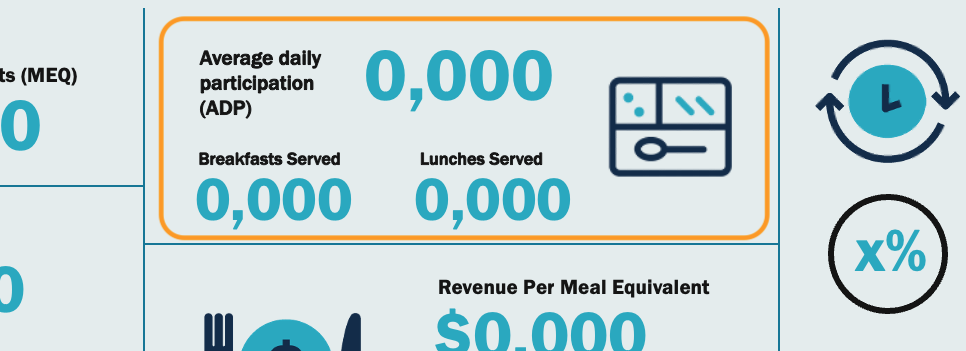
- Breakfasts and Lunches Served
- Meals per Labor Hour
- Average Daily Participation
Tell your school nutrition program’s value and success story
It’s easy for a school nutrition program’s most important financial and student-impact statistics to get lost in a sea of data. Our nutrition program performance template helps you elevate your most important numbers to both stakeholders and your own team. It’s your flashcard of vital statistics that shows your program’s financial strength and contribution to supporting the whole child. After all, well-fed students go back into the classroom fueled and ready to learn.
Telling a positive story also matters when stories about unpaid meal debt and other nutrition program challenges dominate headlines. This is your chance to remind district leaders, your school board, and your school community that nutrition is vital to student success. It’s generating a substantial portion of its own operational funding, and it’s feeding students who, in some cases, depend on school meals as part of their weekly diet.
These KPIs highlight your nutrition program’s value:
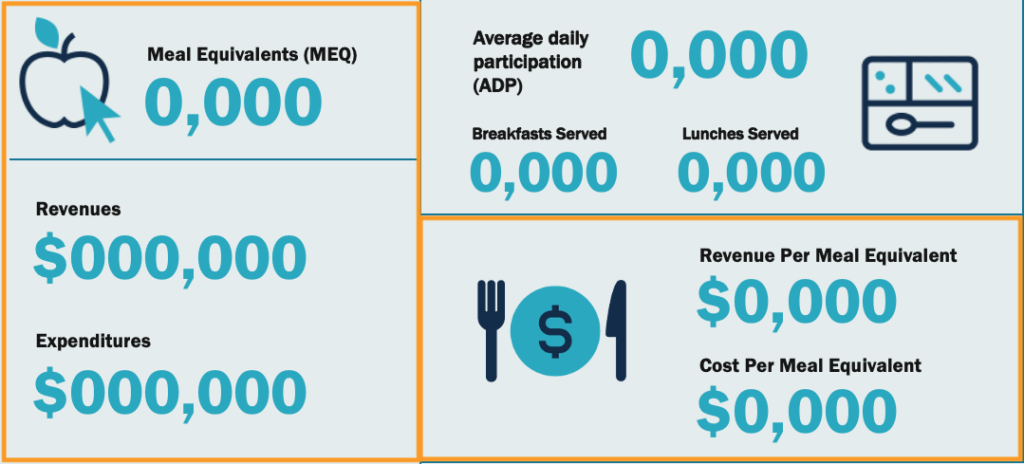
- Meal Equivalents
- Revenues and Expenditures
- Revenue Per Meal Equivalent
- Cost Per Meal Equivalent
Make Data-Driven School Nutrition Decisions
Past performance gives you powerful insight to drive informed decisions. You can recognize trends, spot developing challenges, and objectively judge what’s working and what’s not. Every school nutrition program is unique, so your historical KPI data provides vital information. Data can help you prove the business case to stakeholders and your team, and it can even help you gain valuable team buy-in for changes in process, strategy, or even your FOH and BOH management systems.
All of the KPIs on our template can help you continuously improve your nutrition program over time. However, some stand out as particularly useful. Measure past performance against results after a change or find the root of problems like cost overruns and staffing shortages. Updating the template at a regular cadence, and saving each edition, gives you a snapshot look at your most important metrics without sorting through spreadsheets or raw data. In a few clicks, you could easily flip through a year of data for a clear, honest look at your program’s performance over time.
These KPIs inform data-driven school nutrition program management decisions:
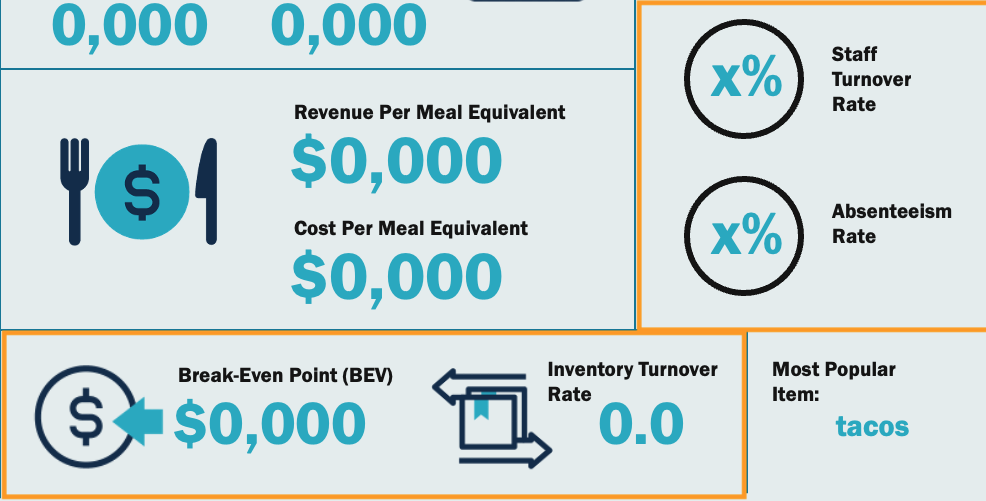
- Break-Even Point
- Inventory Turnover Rate
- Staff Turnover Rate
- Absenteeism Rate
Plus, you can use the “Most Popular Item” box to track students’ preferences and plan menus that increase student participation, reduce waste, and inspire happy, healthy lunchtimes.
Celebrate your nutrition program and your people with this KPI presentation template
Now you have an easy tool to show appreciation for your staff and the value of your nutrition program. Feel free to download the template and edit it to your liking by adding your school logo, adjusting the colors, or even adding or removing statistics to reflect your program’s success at its best. This template is yours to use in a slide presentation or as a stand-alone testament to your program’s contribution to whole-child support.
Bonus: Learn how to ace your school nutrition end-of-year wrap-up
You can also use this free K‑12 school nutrition program guide to help you check all the boxes and prepare for a successful return to school in the fall. Check it out for best practices, expert insight, and practical checklists.
